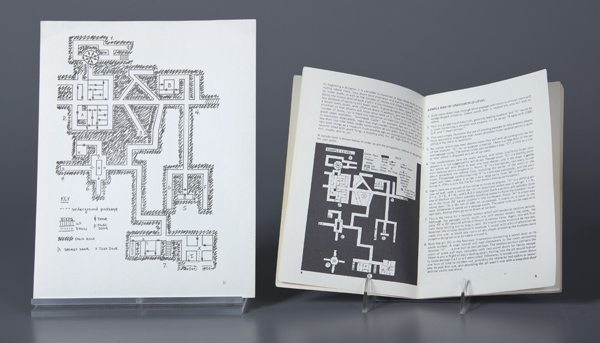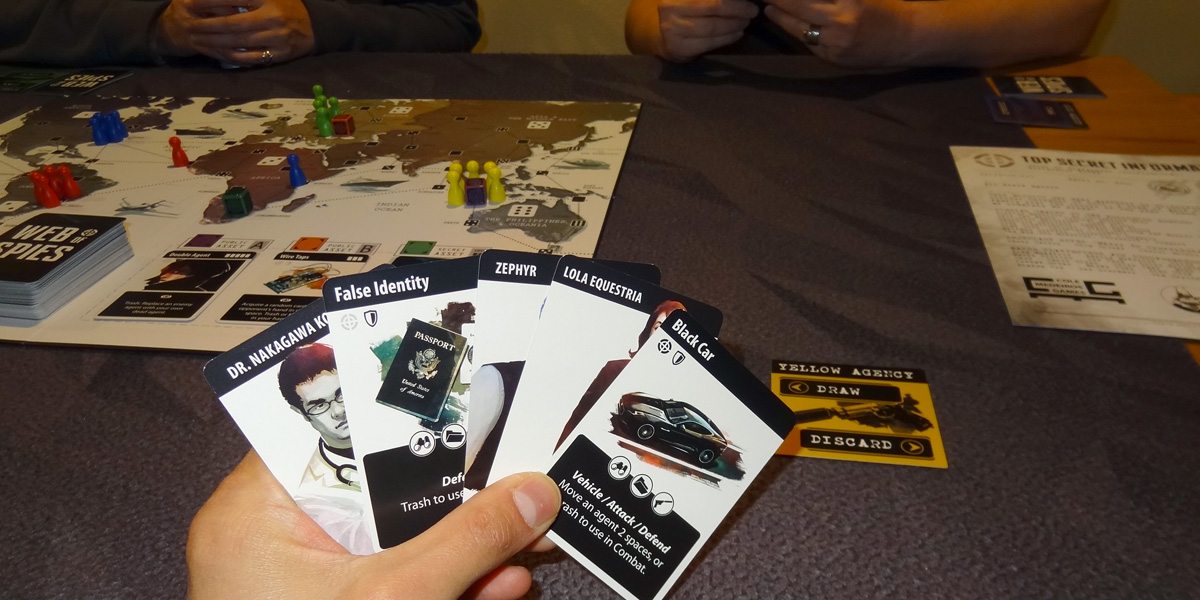
In Reaping the Rewards, I take a closer look at the finished product from a crowdfunding campaign. Today’s title is Web of Spies, which funded in November 2014 and was shipped to backers at the end of September. The project raised just over its goal of $30,000, and the estimated delivery date was July 2015. So it was a few months late, but not too far off, and I think it was worth the wait, based on how it turned out.
At a glance: Web of Spies is a game by Cole Medeiros for 2 to 4 players, ages 14 and up, and takes about an hour to play. It combines deck-building with movement around a map and player-vs.-player attacks. I think the age rating is probably mostly for content–various weapons and espionage-related cards–but I have played it with my kids (9 and 11) and the gameplay can certainly be taught to kids as young as 8. The game is currently available directly from Cole Medeiros at his website for $40. There is also a Secret Mission expansion for $20, though I did not receive that so it will not be included in this review.
My original review of Web of Spies explains how the game works in more detail in case you’re not already familiar with the game. Here I’ll focus more on the final component quality.
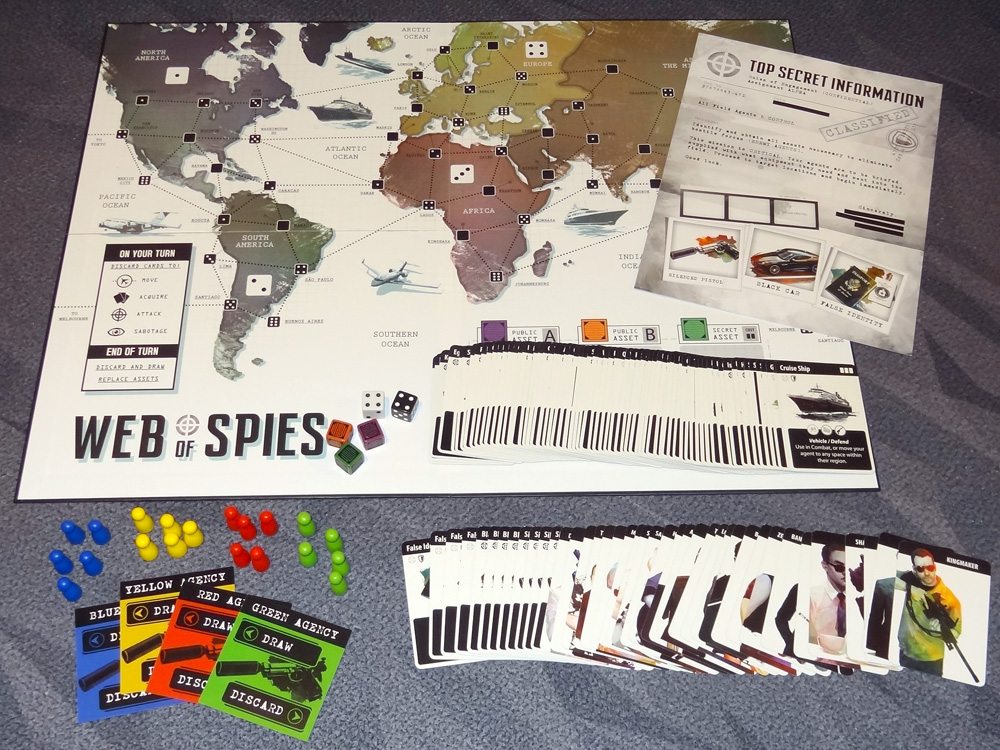
Components:
- 1 game board
- 108 cards (40 Starting cards, 68 Asset cards)
- 4 player mats
- 2 six-sided dice
- 3 Asset markers
- 20 Spy pawns (5 per player)

The components list is the same as in the prototype I reviewed, but of course now they’re finished quality. First, the asset markers and pawns: the people are now pawns, and the assets are cubes, which is nice. No more accidentally moving assets around the board! The pawns are standard-looking wooden pawns. The asset markers are actually custom dice–acrylic cubes made to look like crates, in three different colors.

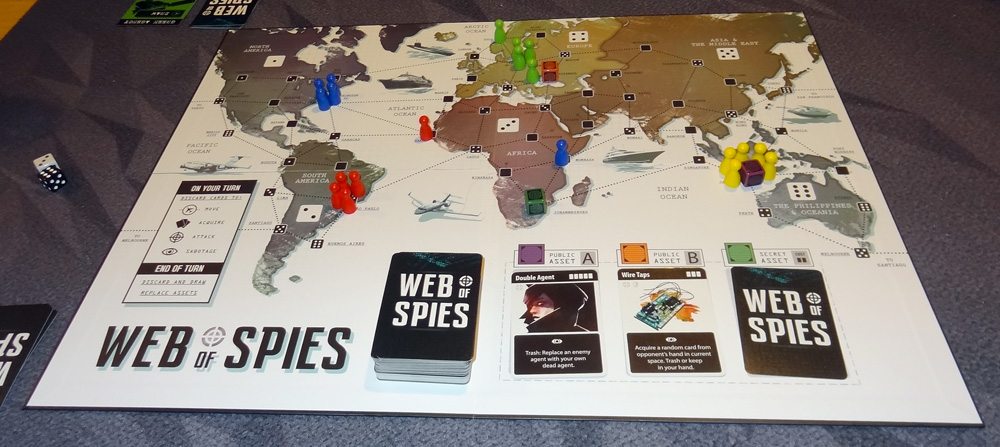
The game board is pretty similar to the original look–a map of the world, with various cities marked and dotted lines connecting them. The colors have been toned down a little (to match the rest of the artwork) and there are some more background details. It’s a nice, understated board. My only complaint is that it’s most natural to place pawns and asset markers directly on the square die icons for the cities, which means that when you’re rolling dice to determine a location you often have to move things around to figure out where it is.
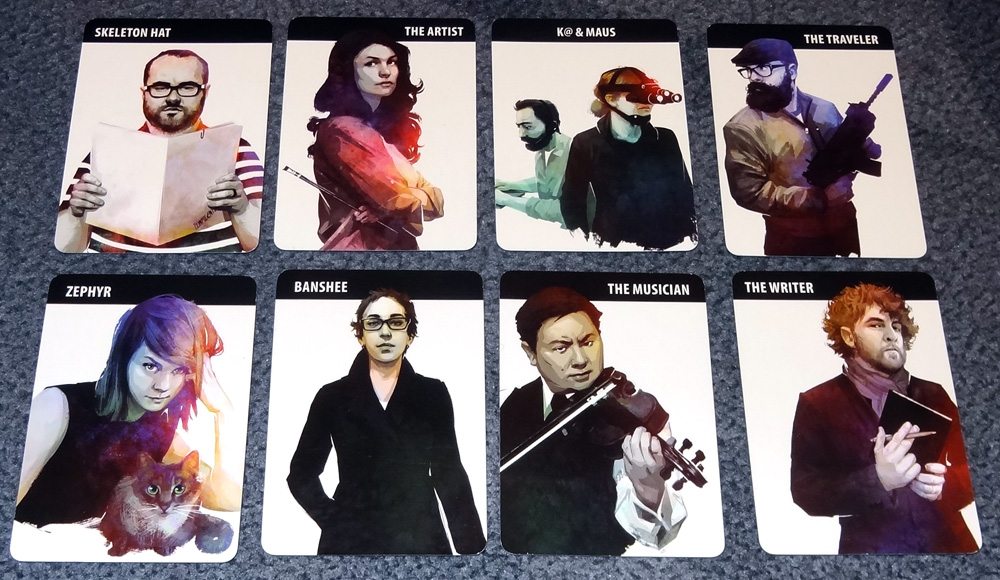
The biggest change, visually, is the artwork on the cards. The cartoony spy guy is gone. Instead, the 28 spy cards (the starting cards that don’t really do anything special) are now 28 custom portraits of Kickstarter backers, and they look awesome. I kind of wish I’d backed at that high level now, because I love how these turned out. The artwork, by Christine MacTernan, combines splashes of color with realistic people and items, and it’s a great step up from the prototype artwork seen in my Kickstarter review.

The card quality is good–linen finish with a nice snap–but they will wear noticeably on the edges, particularly since the backs are black. And since it’s a deck-building game, there will be a lot of shuffling. I don’t generally sleeve my cards, so I expect they’ll just look worn after a while.
The Rules
The basic rules to the game haven’t changed from when I reviewed it, so if you want an in-depth look at gameplay, hop over and look at the “how to play” section. The main change is in the end game. If there are tied players when somebody is eliminated, the game goes into “Code Red.” From now on, any player who loses a spy is completely eliminated–basically it speeds things up. Also, when you eliminate a spy, you don’t take the pawn as a trophy.

There are also some new variant rules included, some in the setup and some for end game and tiebreaker variants.
Single Region has all players start in the same region (in different cities), and assets cannot start the game in that region.
Scattered has players set up spies all over the board, rather than having all of each player’s pawns in a single city.

Fully Loaded gives each player 3 cards from the asset deck during setup, so everyone has three secret assets right off the bat. This gets things going more quickly, but can also be somewhat unbalanced.
Quicker Game just starts with fewer spies per player (though you should have at least 3 per player).

Instead of the “Code Red” end game, you could use one of the following:
Elimination is the original rules–if a player is eliminated and there is a tie, keep going until another player is totally eliminated, and then check the win condition again.
Total Elimination is a longer version–keep going until only one agency remains.
Trophy Kills reintroduces the idea of keeping pawns as trophies when you kill a spy. In this case, when a player is eliminated, the winner is the player with the most trophies. Tied players continue but all other players are also eliminated.
Sudden Death is a slight twist: when a player is eliminated, the game goes into Sudden Death mode. The first player to pull ahead, either by gaining new agents or killing enemy agents, wins immediately.

The Verdict
The gameplay of Web of Spies is, for the most part, the same as it was when I played the prototype, so my opinion of it is also about the same. I still really enjoy playing it–I think it’s a cool mix of deck-building and movement on a board. Certainly, for those who feel that many deck-building games are multiplayer solitaire, this game solves that problem. It’s all about the player interaction, whether you’re camping out on an asset to prevent somebody from buying it to direct attacks on each other.
While I don’t remember all 68 asset cards from the prototype, many of them seem fairly similar. I know there were at least a few that I didn’t remember from before. I still think it would be nice to have more cards that let you weed your deck–I think there are only 2 or 3 that end up getting rid of cards in your deck. But the fact that the assets, other than the starting cards, are all unique, is pretty impressive. Nobody will have the same deck. The secret asset is a great mechanic, too–in this game, knowledge is power, and buying an unknown card gives you leverage over your opponents, even if it’s actually a weak card.
As I mentioned in my original review, if players are hesitant to attack each other, the game can drag on a bit. You really do need to go on the offensive to move the game along.
With the finished artwork, though, Web of Spies really shines. It looks great and I’ve enjoyed playing it both with adult friends and my kids. If you love the spy genre, it’s worth checking out.
For more information, visit the Web of Spies website.
Disclosure: I received a review copy of this game.


